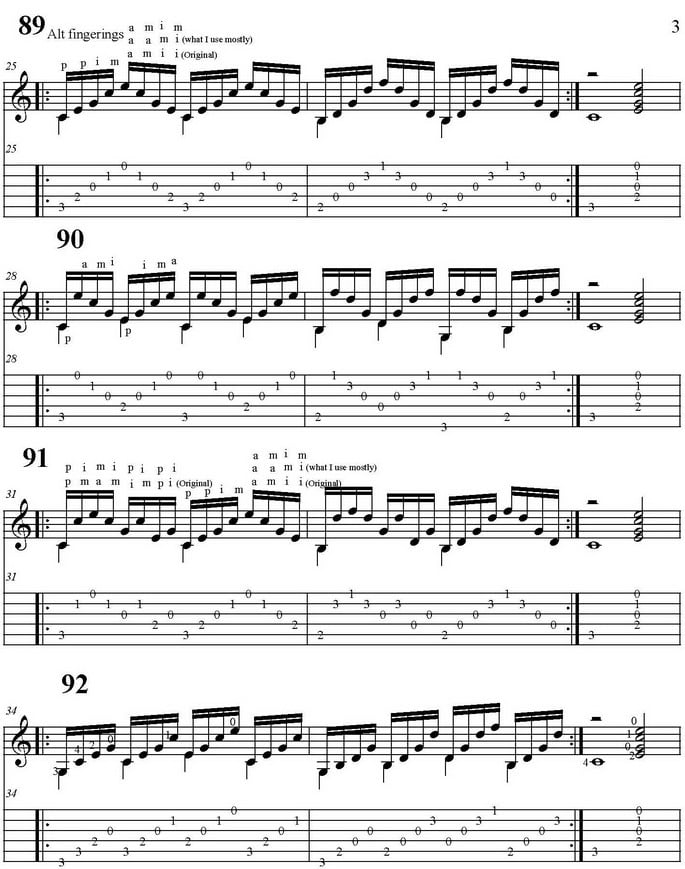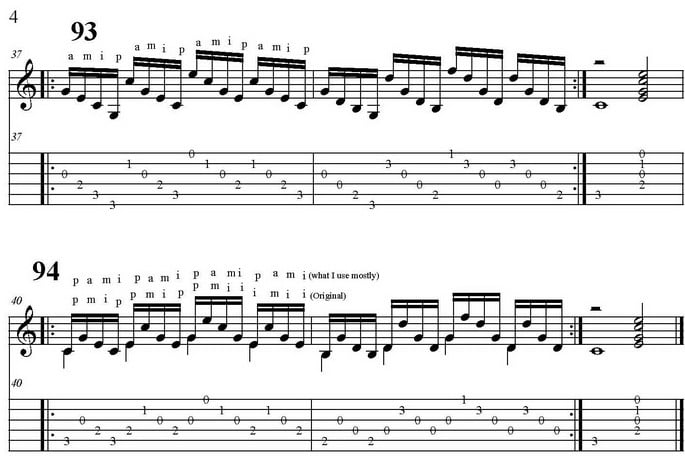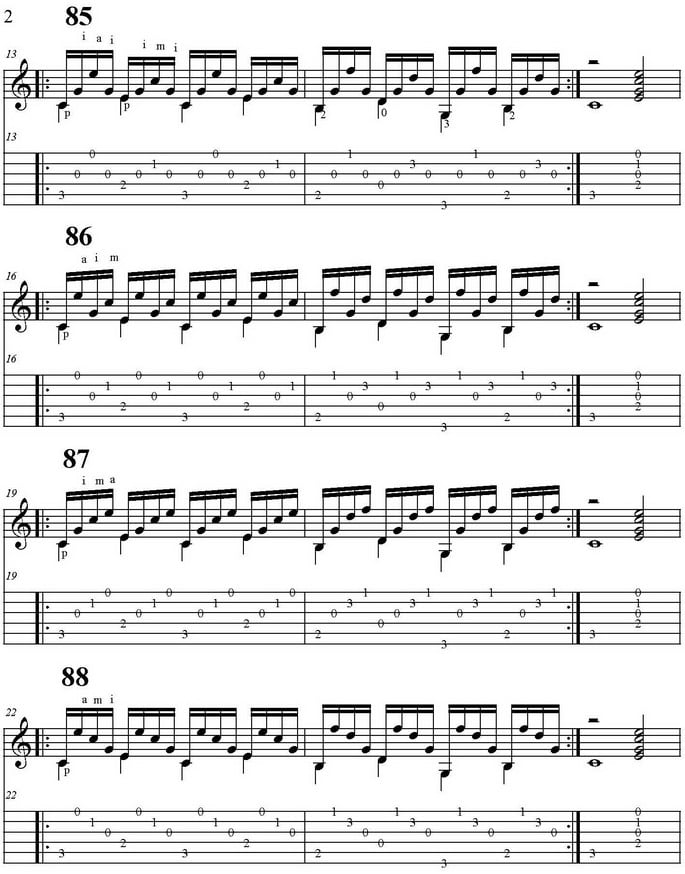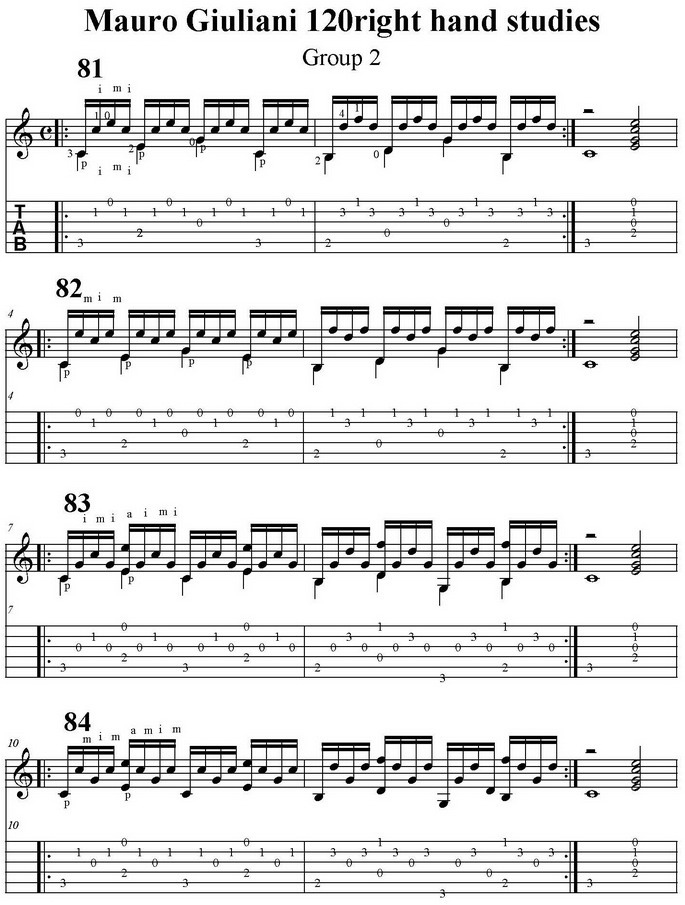now playing:
More
- Giuliani's 120 Etudes For the Right Hand (10/10)LEVEL 4The final chapter of this long right hand technique builder. Most important concepts of the whole series here!
- Right Hand IILEVEL 4Whilst remaining within Alternate Picking, let's focus on hand sync.
- Right Hand ILEVEL 3Let's get into the right hand technique - Alternate Picking basics.
- Fingerstyle GuitarLEVEL 3In this fingerstyle guitar lesson we will see some right-hand arpeggios to improve our fingers dexterity and independence.
- Right Hand Technique For ChordsLEVEL 1Essential right-hand techniques needed to play your first song: Strumming with Ups, Single String Picking and Fingerstyle
- Metal RhythmLEVEL 5Let's focus on rhythm again, but this time we'll take a look at something faster.
- String CrossingLEVEL 4Let's polish our alternate picking technique by deep diving into string crossing.
- Right Hand RhythmLEVEL 1Basic strumming patterns to take you to the next level.
- Giuliani - Sonatina (2/4)LEVEL 3In this part the theme gets one more voice, and is more difficult than the first part, but still an easy one. Also, it is a good exercise for right hand fingers.
more
easier
Feedback
 Gerardo Siere17th September 2008
Gerardo Siere17th September 2008Sorry for being so late with this one. Thanks everyone foy your amazing comments.
 Kristofer Dahl15th September 2008
Kristofer Dahl15th September 2008What a fantastic right hand excercise lesson Gera!

 Vinod Saranga14th September 2008
Vinod Saranga14th September 2008Great technique builders
Weldone Gera
 Hisham Al-Sanea13th September 2008
Hisham Al-Sanea13th September 2008wonderful Gera.excellent lesson
 Danilo Capezzuto13th September 2008
Danilo Capezzuto13th September 2008Wow! What a lesson! I'll sure practice these exercises!
 Kosei Kubota13th September 2008
Kosei Kubota13th September 2008Excellent lesson!
Very informative and comprehensive.
Respect. Carlos Carrillo13th September 2008
Carlos Carrillo13th September 2008Tus melodias son hermosas Ger!! Gran sentimiento!! Vamos Ger nomas!!
 sigma712th September 2008
sigma712th September 2008wow a lot of useful info and exercises here Gerardo. U have quite the vocabulary!
 Bogdan Radovic12th September 2008
Bogdan Radovic12th September 2008Very useful exercises Gerardo!

Alex8712th September 2008
Nice lesson Gerardo, i gotta work on this fingerpicking style

 Muris Varajic12th September 2008
Muris Varajic12th September 2008Well done!!
 Emir Hot12th September 2008
Emir Hot12th September 2008Again another nice one.
 Ivan Milenkovic12th September 2008
Ivan Milenkovic12th September 2008Very extensive series mate, great job

 Nazgul12th September 2008
Nazgul12th September 2008Awesome series. Gonna practice this with my old acoustic.

Practicing Peers
- Total views: 0
- Member views: 0
- Guest views: 0
- Lesson
- My notes
Hello, how are you doing, if it is the first time you're seeing this excercises go to the first of this lesson series, they are a lot easier than this group.
This time I will add some commentaries on the other videos as things gets more complex: (vids 3, 4, 7, 8, 9, 12, 13, 14).
I suggest you approach every arpeggio formula alone, even with open strings if you have trouble. If you are playing open strings, remember to keep the thumb in the correct string.
The difficulties here are
1) the opening between your thumb and the other fingers,
2) simultaneous action of thumb and other fingers,
3) consecutive fast stroke with thumb
4) two adjacent strings played with the same fingering which we´ll be calling here "string glissando"
5) string crossing
To make a string glissando I leave my attacking finger almost fixated after playing the string and let the arm place the whole hand in a good position to play the next string. Both string are played with one finger movement, not two. Some times your finger can just play both strings with out any hand help, every case, every person and guitar are different, sorry.
String crossing is, for example playing the 3rd string with i and the 4th with m, here changing hand's placement is absolutely necessary.
For some formulas I have proposed one or two alternative fingerings, I have marked which was the original I took from the book "Punping Nylon" by Scoot Tenant. I have recently found a XIX century edition where instead of Tarrega´s notation (p-i-m-a), uses staccatto points for fingerings ( . = index), (.. = mediun) (... = ring), also I have lost my first copy of this that should be from in between of XIX century and the 90's so some update on fingerings may appear in the future.
I know Sor, who didn't use nails, avoided a lot the use of ring finger and could do wizzardy stuff with just p-m-i, and also we have to have in mind that guitars were smaller and gut strings were used at that time.
I suggest that this time you play the chords and try hearing what are the melodies involved, this two measure music is not as dull and inocent as one could think at first sight. You can practice them all in continous motion but that becomes some endurance excercise that may be good, but is not the main purpose here, doing the same but changing the formulas in between is far much difficult for your atention and memory, but I still don´t find any good reason to do it in that way, but the great masters of classical guitar seem to have done it this way.
Main video is at 80 bpm and the rest of the videos are at 50 bpm, I added a lot of backing tracks and a funny habanera style jam-track.
Have "fun" (I know techniques is not so funny). Hope you like it, see you.



From this course:
- Giuliani 120 right hand studies (1/10)LEVEL 3The main goal here is to be able to play any of this arpegio comfortably at various speeds.
- Giuliani 120 Right Hand Studies (3/10)LEVEL 5Deals with simultaneous action from thumb and other fingers, and line independence.
- Giuliani 120 Right Hand Studies (4/10)LEVEL 3Several short right hand finger picking studies grouped on similar rhythmical difficulties.
- Giuliani 120 Right Hand Studies (5/10)LEVEL 3Several short right hand finger picking studies grouped on similar rhythmical difficulties.
- Giuliani 120 Right Hand Studies (6/10)LEVEL 4Several short right hand finger picking studies grouped on similar rhythmical difficulties.
- Giuliani 120 Right Hand Studies (7/10)LEVEL 4Several short right hand finger picking studies grouped on similar rhythmical difficulties.
- Giuliani 120 Right Hand Studies (8/10)LEVEL 3Several short right hand finger picking studies grouped on similar rhythmical difficulties.
- Giuliani 120 Right Hand Studies (9/10)LEVEL 3Exercises for the right hand finger picking, grouped into similar rhythmical patterns.
- Giuliani's 120 Etudes For the Right Hand (10/10)LEVEL 4The final chapter of this long right hand technique builder. Most important concepts of the whole series here!
Scrubbing / forward / rewind: arrow right, arrow left keys
Jump to start: Home or `s` , you can also click/tap the lesson part again (the numbers above player)
Go to next part: PageUP or End.
Volume: ArrowUp / ArrowDown keys
Go to any part: Number keys (combinations also possible)
Pause or play: `k` or space key
Fullscreen: `f`, esc to close
Increase / decrease speed : `+` or `-`
Jump to start: Home or `s` , you can also click/tap the lesson part again (the numbers above player)
Go to next part: PageUP or End.
Volume: ArrowUp / ArrowDown keys
Go to any part: Number keys (combinations also possible)
Pause or play: `k` or space key
Fullscreen: `f`, esc to close
Increase / decrease speed : `+` or `-`







